Completely redesigned with advanced technology and iconic style, the all-new 2021 Escalade is now arriving at Cadillac dealerships. (Fig. 1) With innovative features like a curved Organic Light Emitting Diode (OLED) instrument display, an AKG automotive audio system and the latest Super Cruise driver assistance system, the 2021 Escalade adds a new dimension to the full-size luxury SUV market. In addition to its extensive technology, the Escalade delivers improved driving dynamics and significantly greater passenger and cargo capabilities.
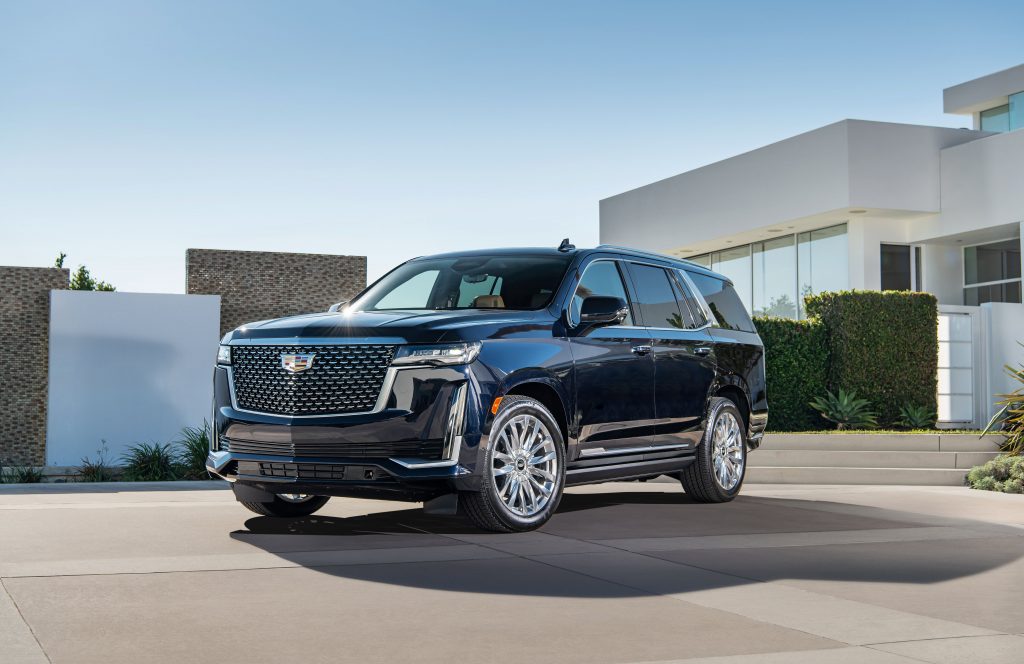 Fig. 1
Fig. 1
Sleek Styling
The 2021 Escalade maintains Cadillac’s signature vertical lighting element, but the new interpretation adds a sleek, horizontal headlamp. The tall, vertical, rear light signature continues but adds deep three-dimensional layers and finishes with detailed etching. Twenty-two-inch wheels are standard and strengthen Escalade’s bold appearance.
A Sport trim, offered for the first time, is set with a black mesh grille and black trim across the exterior. Luxury and Premium Luxury models showcase a bright Galvano finish, while Platinum models top the range with unique interior and exterior details. (Fig. 2)
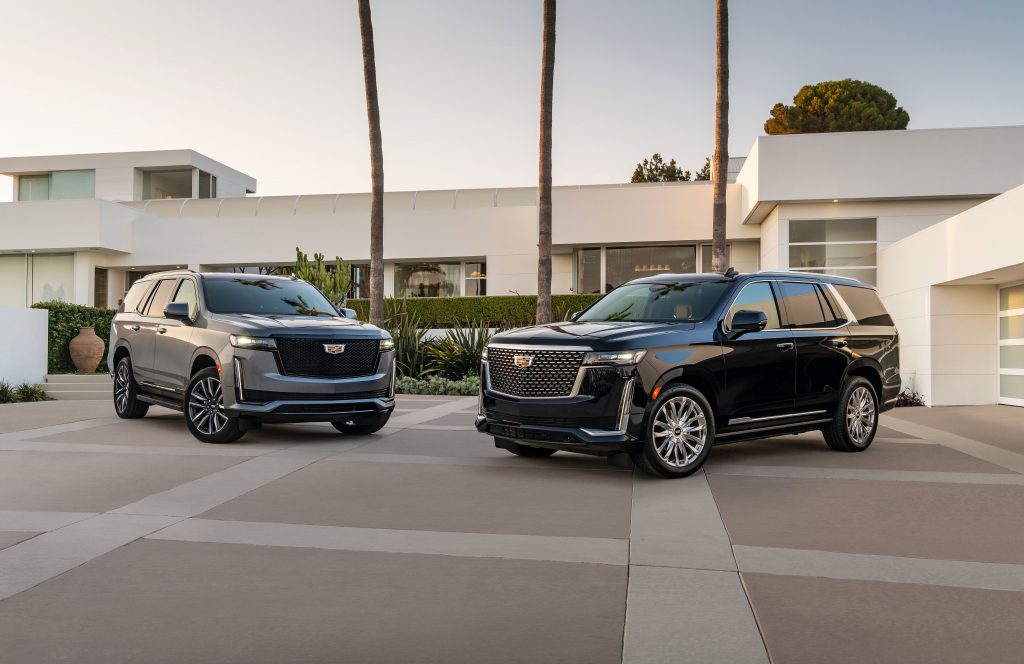 Fig. 2
Fig. 2
The Escalade continues to be available in short- and long-wheelbase versions. The Escalade has a 211.9-inch wheelbase and up to 94.2 cubic feet of cargo space while the Escalade ESV has a 226.9-inch wheelbase and up to 129.9 cubic feet of cargo space. Both models are available with the all-new 3.0L Duramax turbo-diesel or the updated 6.2L V8 engine with Dynamic Fuel Management.
The 2021 Escalade is designed and engineered with GM’s Vehicle Intelligence Platform (VIP). The advanced data communication platform enables additional system capacity and responsiveness, increased over-the-air vehicle software update capability, and enhanced cybersecurity.
Gas and Diesel Engine Choices
The Escalade is available with the new 3.0L Duramax Diesel inline 6-cylinder engine (RPO LM2) or the gas powered Gen 5 6.2L V8 engine (RPO L87). Both engines feature a stop/start system for enhanced efficiency.
The 3.0L turbocharged diesel engine is part of the Cylinder Set Strategy (CSS) family of engines, which offer reduced friction, weight, and exhaust emissions while also delivering fuel economy that surpasses the engines they replace. The turbocharger system includes an electronically operated wastegate valve and provides good low-end torque as well as high-end performance. The diesel engine produces 277 horsepower and 460 lb.-ft. of torque.
The 3.0L diesel engine incorporates solenoid-type fuel injectors that are controlled by the Engine Control Module (ECM). (Fig. 3) The solenoid-type fuel injectors require a special tool for removing the injectors from their bore. However, in extreme cases, use a slide hammer with an M6 x 1.0 thread installed in place of the fuel return banjo bolt. In such cases, ensure all force is directed straight upwards from the fuel injector.
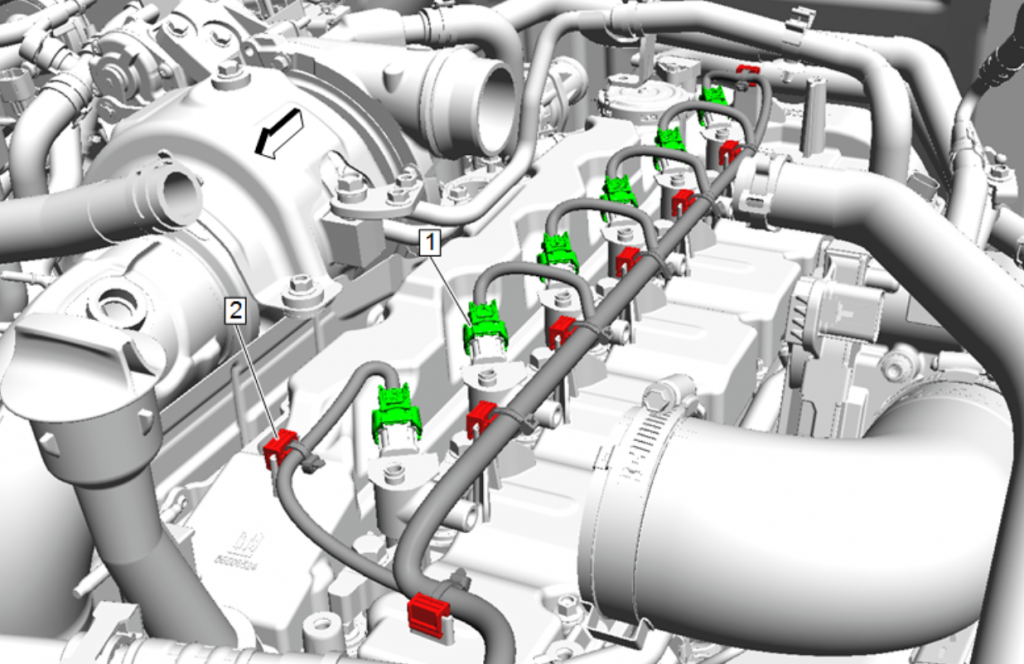 Fig. 3
Fig. 3
The solenoid injectors also require a new injector bore and sleeve-cleaning kit for the engine injector bores. The cleaning kit removes carbon deposits from the fuel injector sleeve bore, which is very helpful during a fuel injector replacement.
The high pressure fuel pump is a mechanical pump attached on the driver’s side of the engine block and is driven by the timing chain. The high pressure pump on vehicle service is similar to other small diesel engines. Access to the pump-driven sprocket can be obtained by removing the fuel pump access cover. Use the special tools to retain engine timing while removing the high pressure fuel pump.
When replacing just the pump, the timing is retained by the tools. If the high pressure fuel injection pump-driven sprocket is removed from the engine, then the timing adjustment must be performed.
The Gen 5 gasoline V8 engine generates 420 horsepower and 460 lb.-ft. of torque. The Dynamic Fuel Management system is an Active Fuel Management™ technology that can deactivate any combination of cylinder valves of the engine, combining millisecond accurate torque control with cylinder deactivation to optimize fuel consumption. (Fig. 4)
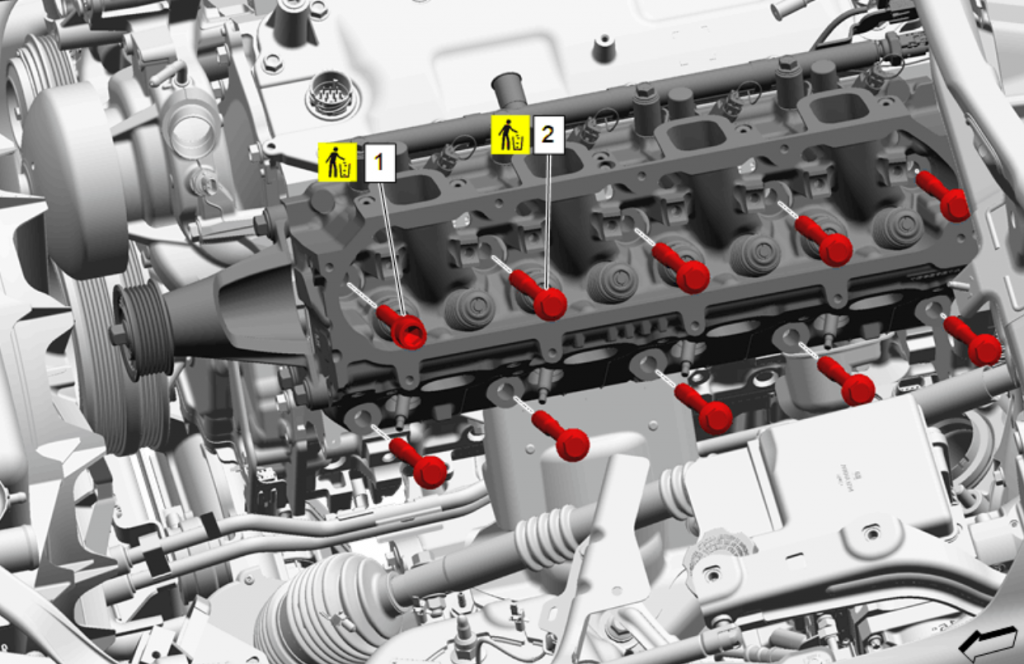 Fig. 4
Fig. 4
The Dynamic Fuel Management solenoid requires a tool to remove the valve lifter oil solenoid valves. The magnetic tool helps gain leverage to remove the valve lifter oil solenoids from the block. Once installed on top of the solenoid, place a hand over the remover and solenoid with a finger under the solenoid. Twist while pulling up on the tool and the solenoid.
The stop/start system on both gas and diesel engines automatically shuts down the engine in appropriate conditions, such as when stopped at a traffic light. To support the increased number of engine starts, a high performance electric starter motor with a stronger pinion engagement mechanism to reduce noise levels replaces the conventional starter motor.
Along with the upgraded starter motor, advanced battery technology is required to ensure the vehicle’s battery can handle the frequent charge and discharge cycles common with stop/start operation. There is a battery sensor module connected to the battery, which continually monitors the battery charge and health state. The ECM uses this information from the battery sensor module to determine if the battery charge and health are sufficient for a stop/start condition. The stop/start system can be disabled using the Auto Stop button on the center console. (Fig. 5) The system turns on each time the vehicle is started.
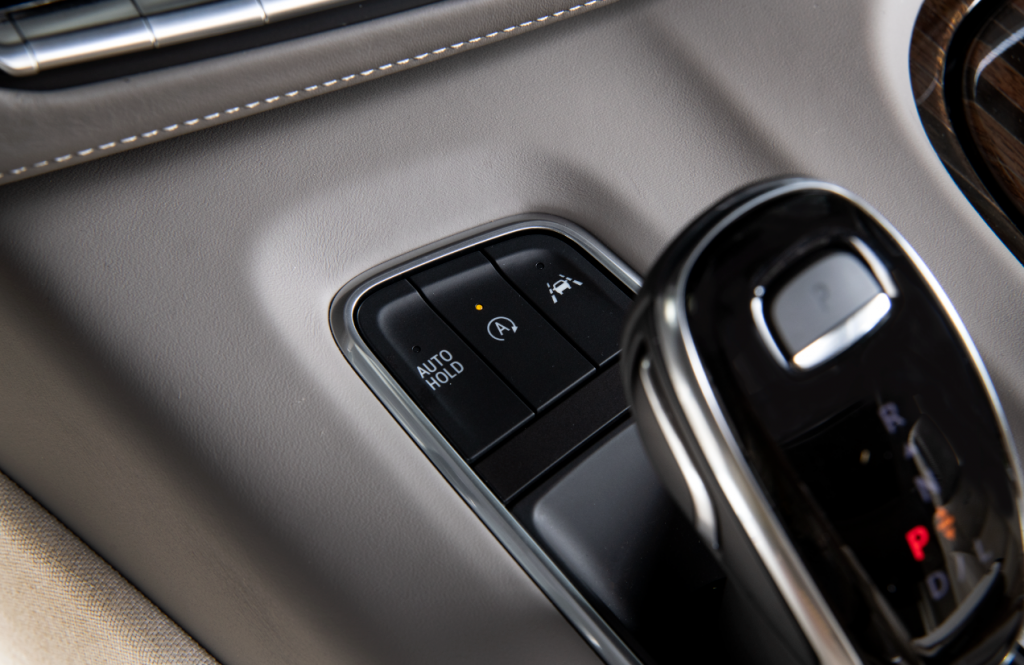 Fig. 5
Fig. 5
10-Speed Automatic Transmission
Both engines are mounted to the Hydra-Matic 10L80 10-speed automatic transmission (RPO MQC). The heavy-duty transmission features a case with an integral bell housing and the unique off-axis variable vane-type pump drive design allows for very low mounting.
The four planetary gear sets provide ten forward gear ratios and Reverse. Changing gear ratios is fully automatic and is accomplished through the Transmission Control Module (TCM). The TCM receives and monitors various electronic sensor inputs and uses this information to shift the transmission using output controls. The TCM is mounted at the left front of the vehicle, behind the underhood fuse block.
The transmission is controlled with the Electronic Transmission Range Selector (ETRS) system, which replaces the traditional column-mounted shifter. (Fig. 6) The ETRS system is a shift-by-wire system with no physical link between the selector controls and the transmission.
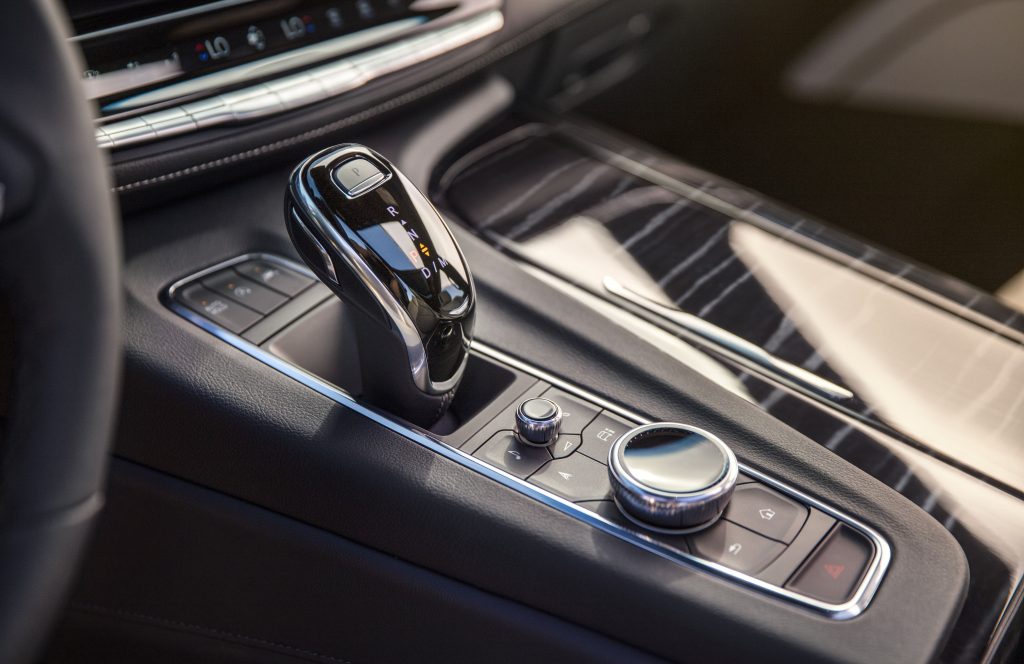 Fig. 6
Fig. 6
The Escalade is offered in rear-wheel drive or all-wheel drive models. Single-speed and 2-speed transfer cases are available on all-wheel drive models: the 3015 1-speed automatic active transfer case (RPO NPO) and the 3025 2-speed automatic active transfer case (RPO NQH). Shift controls are located on the left side of the instrument panel. (Fig. 7)
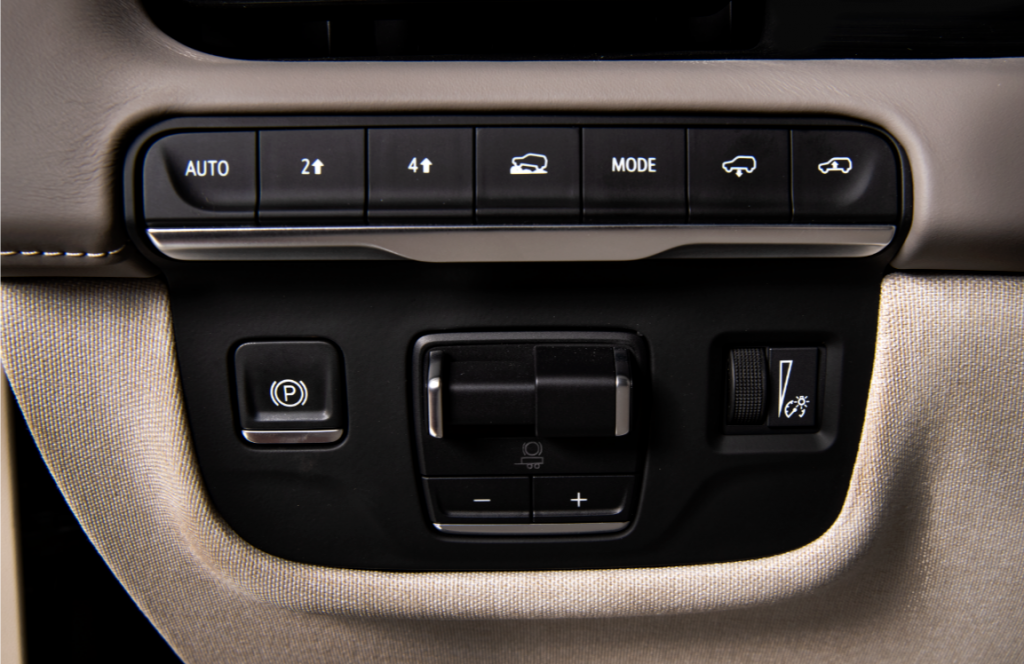 Fig. 7
Fig. 7
Driving Dynamics
The driving dynamics of the new Escalade are enhanced with a new independent rear suspension as well as available Magnetic Ride Control, Air Ride Adaptive Suspension and Electronic Limited Slip Differential (eLSD). The independent rear suspension allows each rear wheel to handle road conditions separately to enhance ride quality, steering responsiveness and overall driver control. In addition, the available Magnetic Ride Control uses sensors to continually “read” the road and alter the damping rate of the shocks almost instantly to reduce vertical body motion, body roll and vibrations.
The available Air Ride Adaptive Suspension delivers automatic load-leveling and ride-height adjustments continuously at all four wheels. In highway driving, the system automatically lowers the ride height to improve aerodynamics; and a driver-selectable setting lowers the suspension 2 inches (51 mm) to aid passenger entry and exit when the vehicle is parked. The vehicle will not lower when exiting if the level switch is in Off-Road mode or the Tow/Haul mode is enabled. The body also can be raised for additional ground clearance when driving off-road. Air Ride Adaptive Suspension settings are shown on the instrument cluster. (Fig. 8)
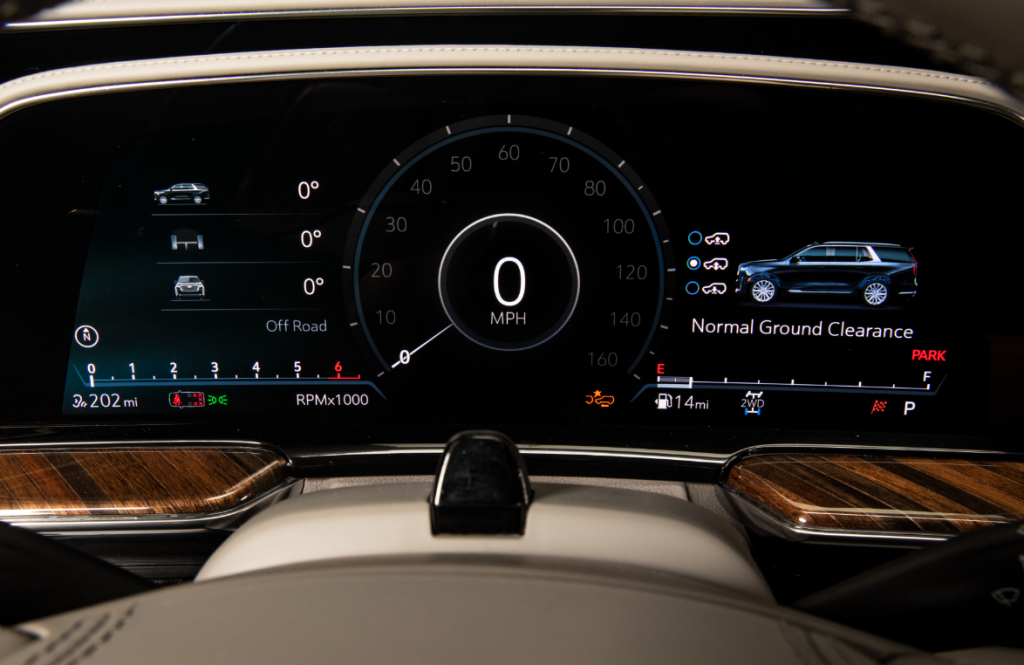 Fig. 8
Fig. 8
To deliver additional traction and power engagement to the rear wheels, the available electronic limited-slip differential (RPO G96) uses infinitely variable clutch engagement to provide torque to the wheel with the most traction, including when cornering and in wet weather conditions. The locking torque causes a multiplication of wheel torque, which can be used to improve traction and/or vehicle dynamics. The differential lock motor actuates a multidisc friction clutch via a reduction gear set. The differential lock motor is used to close and open the clutch.
Safety Systems
The safety systems offered on the 2021 Escalade include various technologies that use radar, camera, and ultrasonic driving assistance. The systems are a comprehensive feature set designed to help a driver avoid collisions or reduce crash damage while driving, backing up, and parking.
Some of the standard or available safety technologies include:
- Forward Collision Alert
- Lane Keep Assist with Lane Departure Warning
- Automatic Emergency Braking
- Front and Rear Park Assist
- Pedestrian Impact Detection
- Lane Change Alert with Side Blind Zone Alert
- Rear Cross Traffic Alert
- Safety Alert Seat
Trailering Package
The Trailering Integration Package offers up to nine camera views to support easier trailer hitching and trailer monitoring. The package also includes an Integrated Trailer Brake Controller and a trailering app that offers trailer profiles, tire pressure and temperature monitoring, and an Extended Side Blind Zone Alert.
OLED Display
Inside the Escalade is the industry-first curved OLED display, which offers more than 38 inches of total diagonal display area with twice the pixel density of a 4K television. (Fig. 9) The technology delivers bold imagery, perfect blacks and the largest color range of any automotive display in production today.
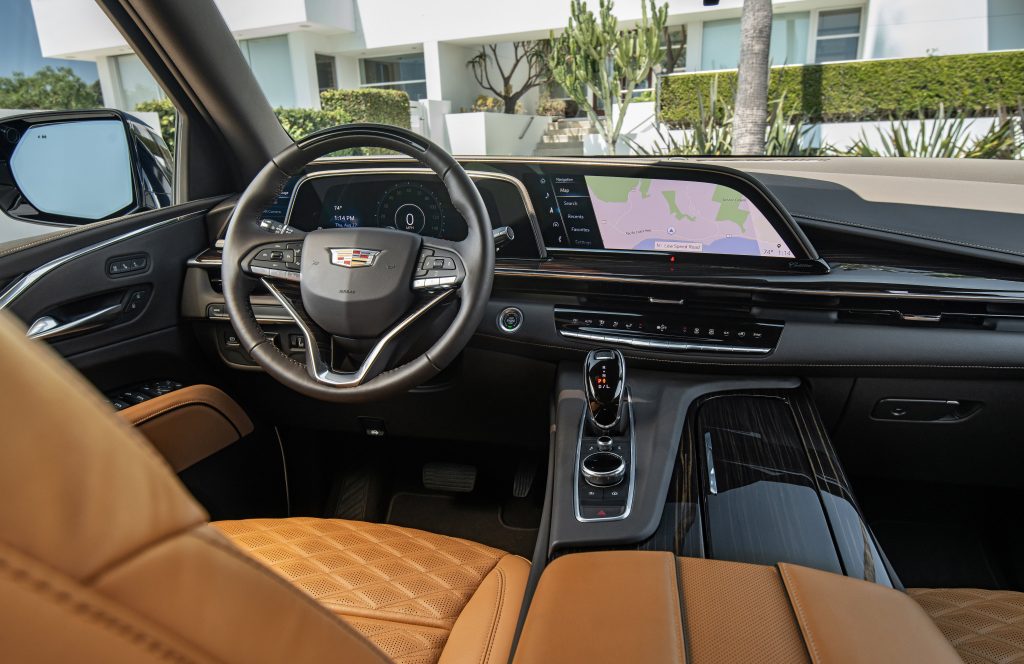 Fig. 9
Fig. 9
The system includes three screens: a 7.2-inch-diagonal touch control panel on the left side of the instrument panel, a 14.2-inch-diagonal instrument cluster display behind the steering wheel, and a 16.9-inch-diagonal Infotainment screen to the driver’s right. The OLED is paper-thin, and its curvature positions the displays for optimal visibility. (Fig. 10) The vivid color and visual quality of OLED technology eliminates the need for the common “hood” shrouding of many typical in-vehicle screens, creating a brighter and less cluttered environment.
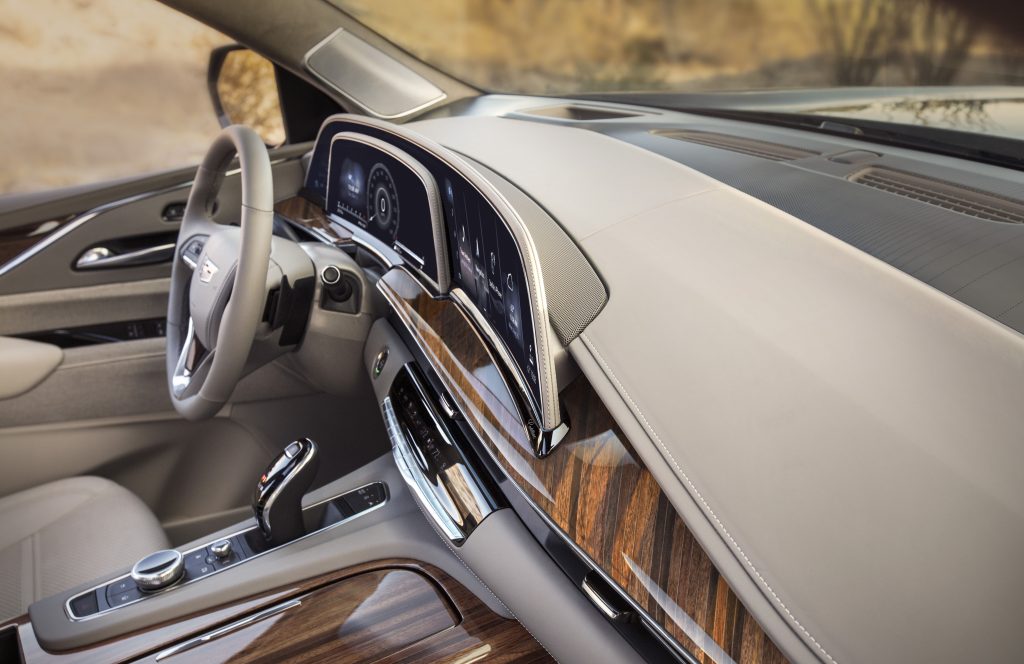 Fig. 10
Fig. 10
AKG Audio Technology
Known worldwide for microphones and headphones used by leading musicians in recording studios and live venues, AKG has brought its audio technology to the auto industry for the first time in the 2021 Escalade.
The Escalade features a standard AKG Studio system with 19 speakers and a large enclosed subwoofer, powered by a 14-channel amplifier. The available AKG Studio Reference system has 36 speakers powered by three amplifiers that deliver 28 channels, offering a professional studio listening experience. (Fig. 11)
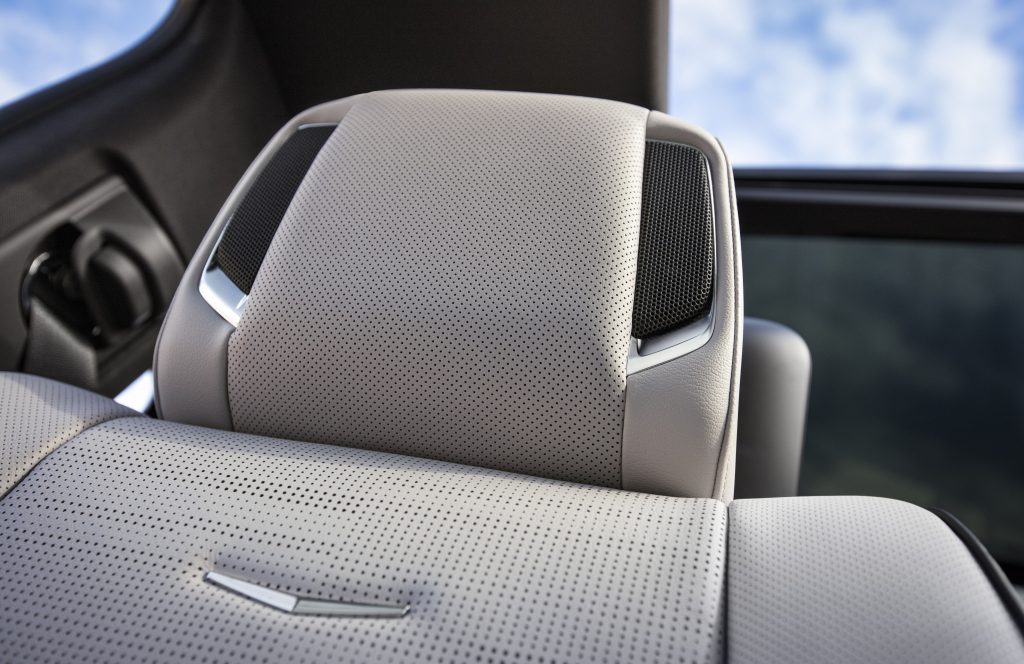 Fig. 11
Fig. 11
Rear Seat Media
The new Rear-Seat Media system features a pair of 12.6-inch-diagonal independent touch displays with navigation as well as streaming capability to play games, music and videos through HDMI and USB inputs. (Fig. 12) The screens can also mirror Android smartphones. In addition, rear passengers can send navigation destination suggestions to the front navigation screen.
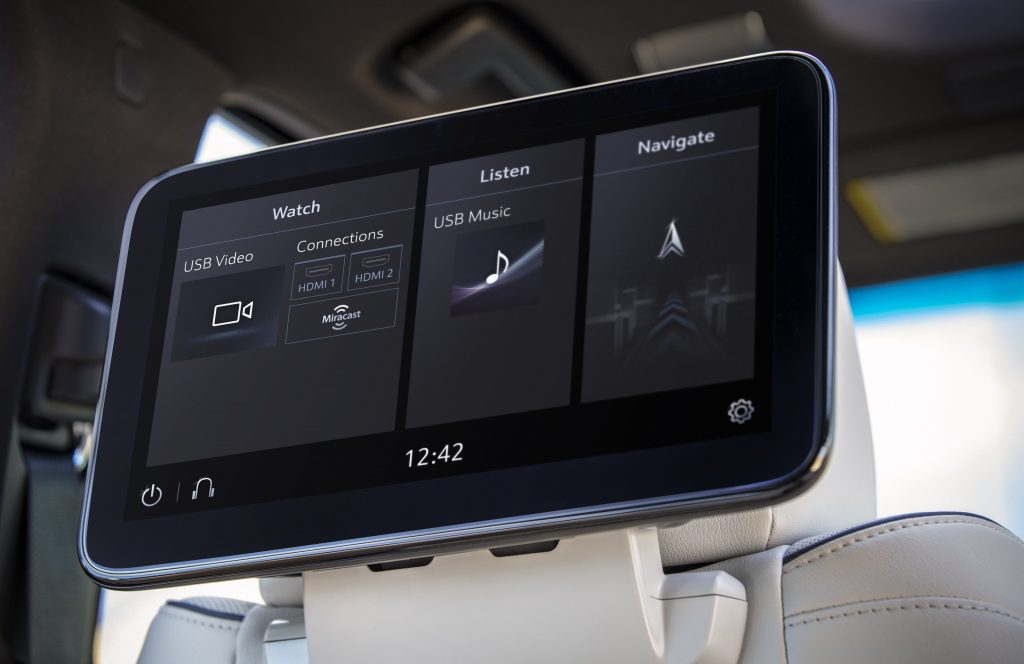 Fig. 12
Fig. 12
The infrared headsets included with the system use AAA batteries (provided) and are automatically connected to the Rear Seat Media screens. The headsets receive audio signals from the infrared transmitter located at the top of the passenger’s side (right) seatback screen. To turn on the infrared headsets, press the Power button located on the right side of the headset ear pad. The infrared headsets turn off automatically after about four minutes if the infrared signal from the system is lost, such as when the Rear Seat Media system turns off or the signal is out of range. Turn off the headsets when not in use to preserve battery life.
Rear Seat Media also supports connections for up to nine headsets via Bluetooth per screen. If customers would like to use their own Bluetooth headsets, they can be paired to the system through the Rear Seat Media screens.
Soft-Close Doors
The available soft-close door feature uses an electric motor to pull each door closed to its primary position after it has been closed over its secondary latch position, eliminating hard door slams.
PDI Special Instructions
During the Pre-Delivery Inspection, check the following special items:
- To use the 110V AC power outlet, at each new ignition cycle, push the 110V AC power button to enable.
- Ensure the hands-free liftgate is set to “Open and Close” under Settings on the infotainment screen.
- Enable the function of the running boards to deploy under Settings on the infotainment screen. Open any door and confirm the running board on that side of the vehicle deploys.
- Ensure that the navigation SD card that is located beneath the USB hub in the armrest console is inserted correctly and is functional.
For more information on the all-new 2021 Escalade, refer to Bulletin #20-NA-211.
– Thanks to Hassan Abdallah and Matt Bunting



















Awesome job Gm guy’s